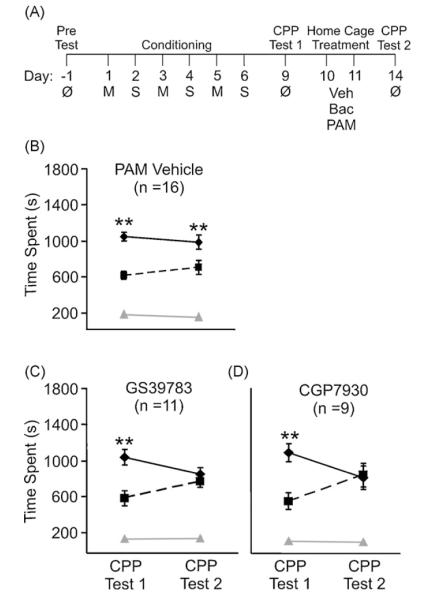Fig. 1.
Meth-induced CPP is inhibited by post-conditioning administration of the PAMs GS39783 and CGP7930. (A) Illustration of treatment protocol. A drug-free Pre-Test was conducted and rats were assigned to receive Meth (1 mg/kg, i.p.) in the initially non-preferred chamber. Conditioning occurred on days 1–6. A drug-free CPP Test was conducted on day 9 to verify the development of CPP (CPP Test 1). Vehicle, baclofen, or a PAM was administered in the home cage on days 10 and 11. A final drug-free CPP Test (CPP Test 2) was conducted on day 14 to determine the capacity of GABAergic ligands to influence the expression of Meth-induced CPP. (B) Rats assigned to the PAM vehicle (10% propylene glycol) group (n = 14) expressed CPP on both Test days (CPP Tests 1 and 2). Rats administered (C) GS39783 (n = 11) or (D) CGP7930 (n = 9) as an intervening treatment did not express a preference for the Meth-paired chamber on CPP Test 2. Post hoc Newman–Keuls test was used to determine between chamber differences (center chamber not included for statistical analysis), **p < 0.01. Solid line, time spent in the Meth-paired chamber; dashed line, time spent in the saline-paired chamber; grey line, time spent in the center chamber. M, methamphetamine (1 mg/kg); S, saline (1 mg/kg); Veh, vehicle (1 ml/kg); Bac, baclofen (2 mg/kg); PAM, positive allosteric modulator: GS39783 (30 mg/kg), CGP7930 (30 mg/kg).

